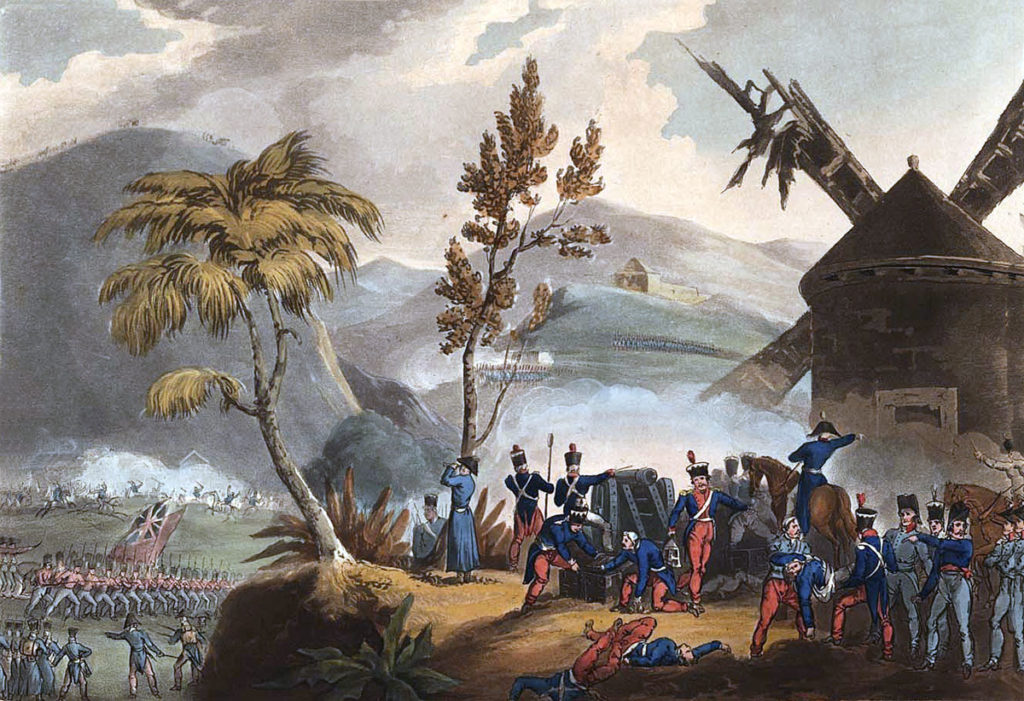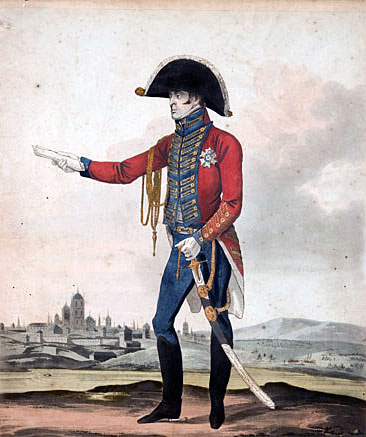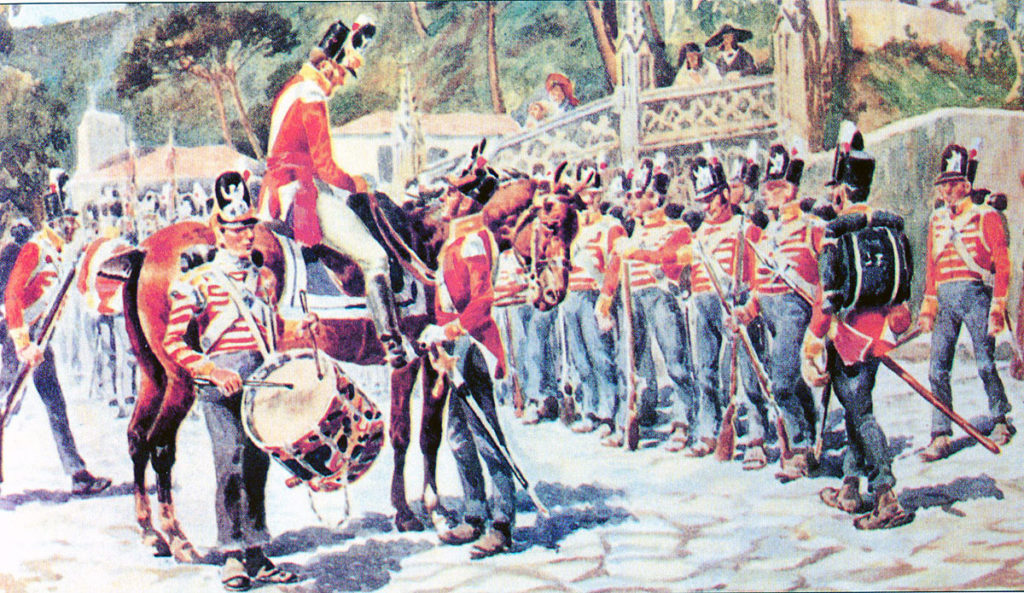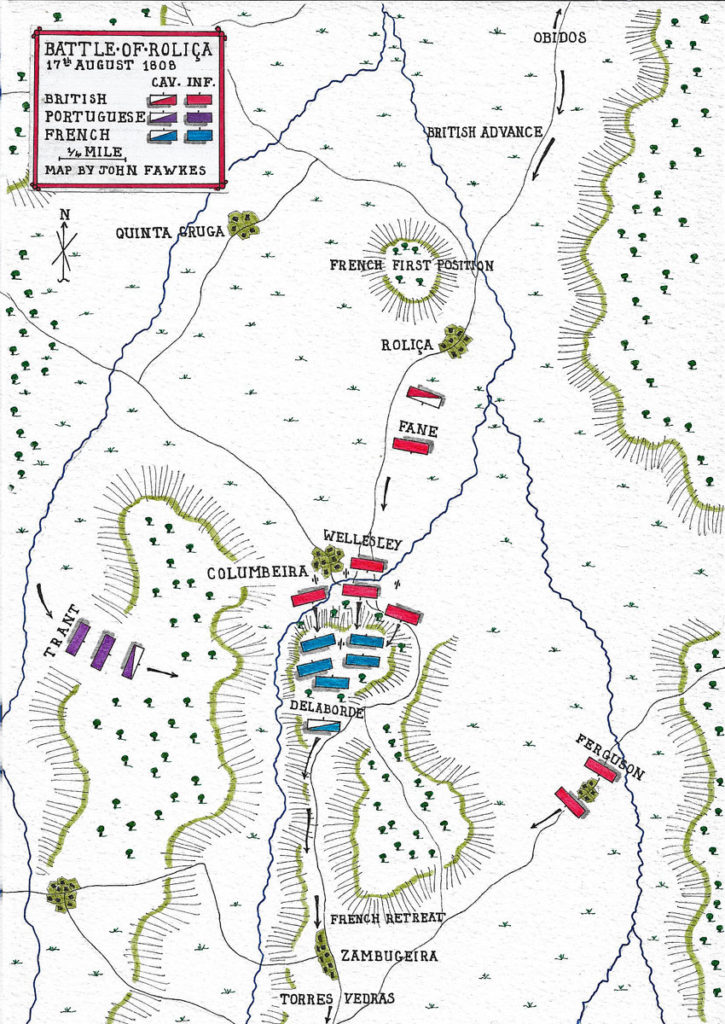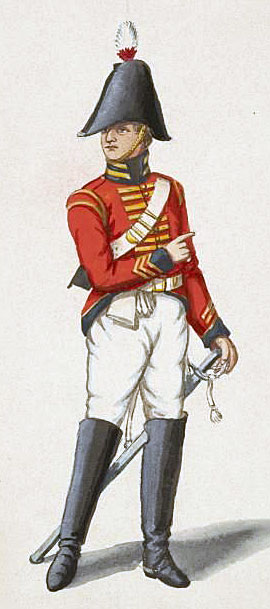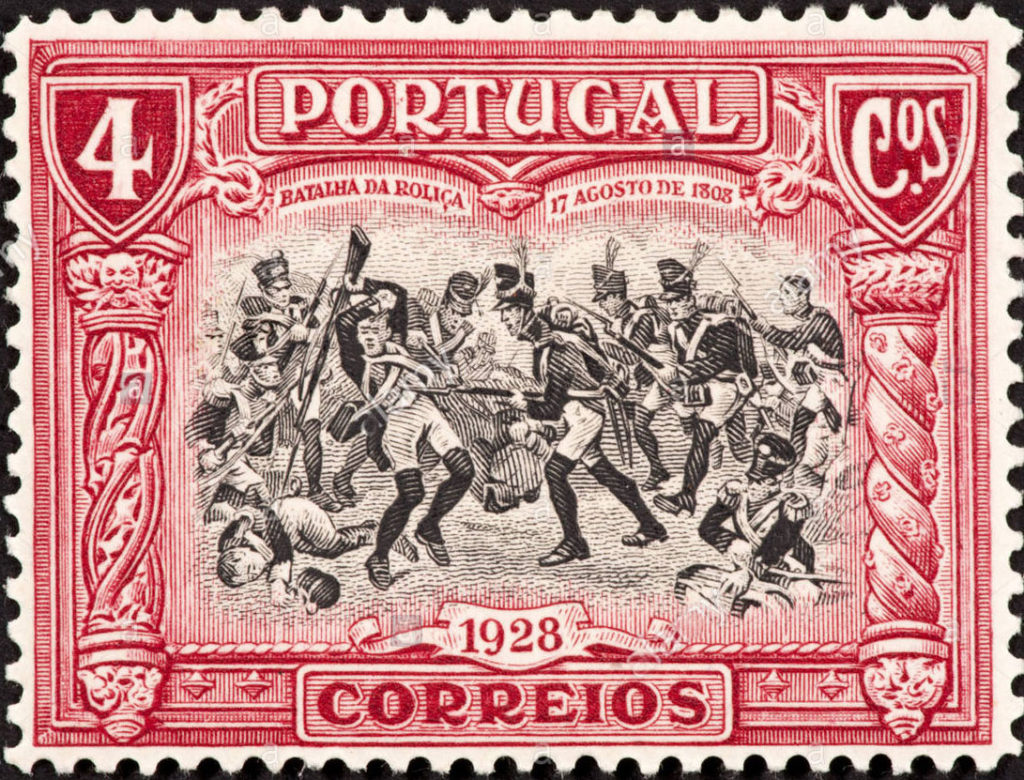The first battle fought by the British in the Peninsular War, on 17th August 1808; also, the first of the string of victories over the French won by Sir Arthur Wellesley, later the Duke of Wellington
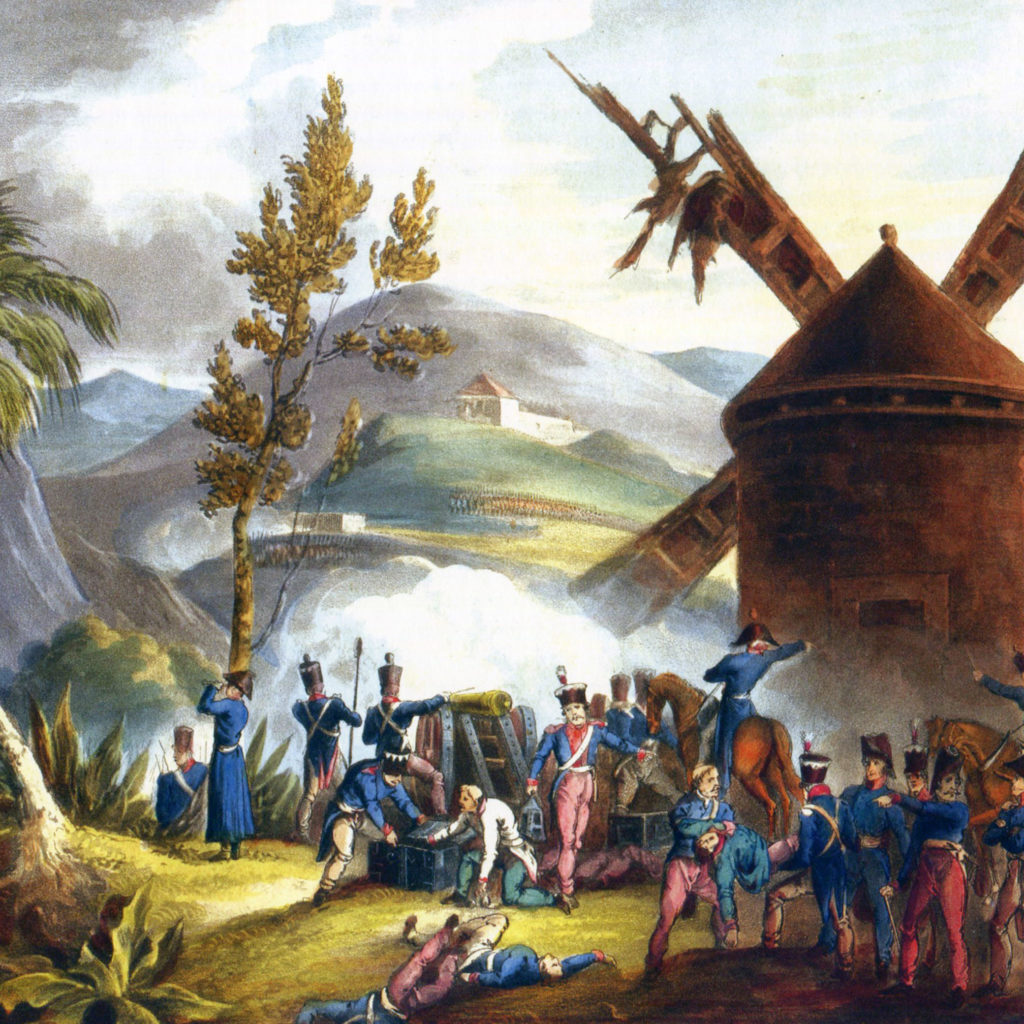
The Podcast of the Battle of Roliça: The first battle fought by the British in the Peninsular War, on 17th August 1808; also, the first of the string of victories over the French won by Sir Arthur Wellesley, later the Duke of Wellington: John Mackenzie’s Britishbattles.com podcast on the battle.
The previous battle in the British Battles sequence is the Battle of Laswaree
The next battle in the Peninsular War is the Battle of Vimeiro
War: Peninsular War
Date of the Battle of Roliça: 17th August 1808
Place of the Battle of Roliça: On the west coast of Central Portugal.
Combatants at the Battle of Roliça: British and Portuguese troops against the French.
Commanders at the Battle of Roliça: Lieutenant General Sir Arthur Wellesley, later the Duke of Wellington, against General Delaborde.
Size of the armies at the Battle of Roliça:
The British army numbered 14,000 British troops and 1,600 Portuguese troops. The British brought into the field 19 guns (ten 6 pounders, six 9 pounders and three howitzers).
The French army numbered 4,000 infantry, 250 light cavalry and 5 guns.
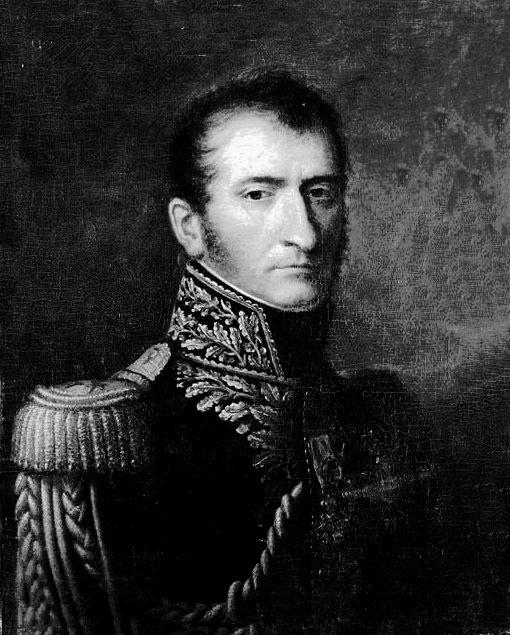
Winner of the Battle of Roliça:
The French were forced to retreat from the field of battle.
Orders of Battle:
British order of battle:
20th Light Dragoons
First Brigade: Major General Hill: 1st/5th, 1st/30th and 1st/9th
Regiments
Second Brigade: Major General Ferguson: 1st/36th, 1st/40th and 1st/71st Regiments
Third Brigade: Brigadier General Nightingall: 1st/29th and 1st/82nd Regiments
Fourth Brigade: Brigadier General Bowes: 1st/6th and 1st/32nd Regiments
Fifth Brigade: Brigadier Catlin Craufurd: 1st/45th, 1st/50th and 1st/91st Regiments
Sixth or Light Brigade: Brigadier General Fane: 5th/60th and 1st/95th Regiments
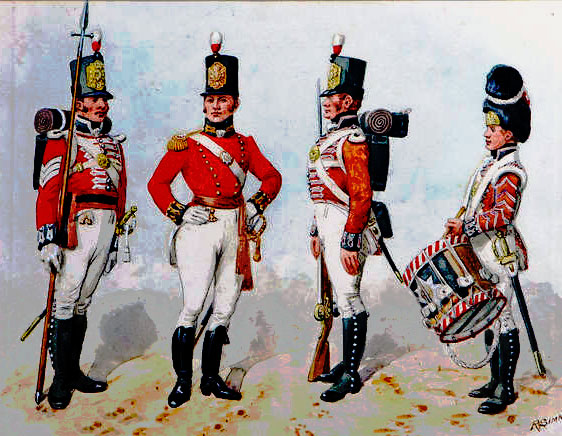
Colonel Nicholas Trant’s Portuguese Troops:
6th, 11th, & 12th Cavalry Regiments
12th, 21st, and 24th line Battalions
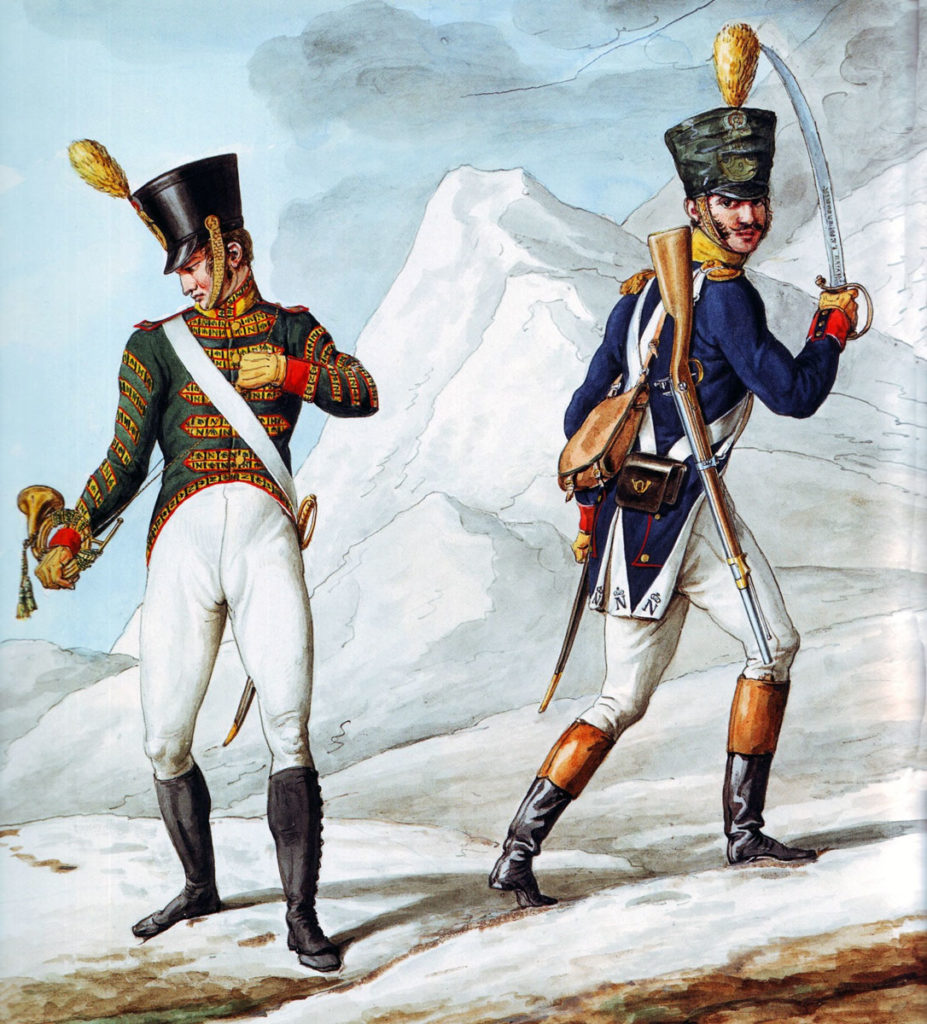
6th Caçadores
French order of battle:
2 battalions of 70th Line Regiment
1st Provisional Light Infantry:
1 battalion of 2nd Light Regiment
1 battalion of 4th Light Regiment
1 battalion of 4th Swiss Regiment
2 squadrons of 26th Chasseurs à Cheval
1 Company of Artillery (5 guns)
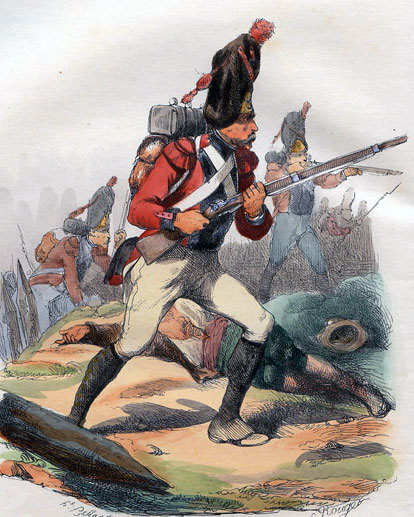
Background to the Battle of Roliça:
Sir Arthur Wellesley’s British army landed in the mouth of the River Mondego on Portugal’s Atlantic coast between 1st and 8th August 1808.
Wellesley’s instructions were to support the Portuguese insurrection against the occupying French army, marching first on the capital, Lisbon.
On 10th August 1808, Wellesley broke up his camp on the River Mondego and began the march south.
The French commander in Lisbon, Marshal Junot, recalled General Loison with his division from central Portugal, at the same time sending General Delaborde, with a small force, to assist Loison in his withdrawal to Lisbon.
Delaborde arrived in Alcabaca on 10th August 1808 and, on 13th August 1808, fell back to Obidos and then to Roliça, leaving a rear guard in Obidos.
On 15th August 1808, Wellesley advanced to Caldas and sent 4 companies of the 60th and 95th Rifles to drive Delaborde’s rear guard out of Obidos.
Pursuing the French too vigorously, the 4 companies had to be extricated by General Spencer and a brigade of infantry, leaving the 2 Rifle Regiments with 29 casualties, including Lieutenant Bunbury of the 95th killed.

The Podcast of the Battle of Roliça: The first battle fought by the British in the Peninsular War, on 17th August 1808; also, the first of the string of victories over the French won by Sir Arthur Wellesley, later the Duke of Wellington: John Mackenzie’s Britishbattles.com podcast on the battle.
Wellesley received news that General Loison’s Division might be near at hand and able to intervene in the attack Wellesley intended upon Delaborde.
In fact, Loison was marching south by an inland route and was too far away to assist Delaborde, but Wellesley’s concern over Loison’s whereabouts was to adversely influence the conduct of his attack on Delaborde.
Fortescue suggests that Wellesley might have begun the operation earlier and possibly captured the whole of Delaborde’s force.
Battle of Roliça:
Obidos stands at the northern end of a plain surrounded by a circle of mountains.
The village of Roliça is situated at the southern end of the plain, two miles from Obidos, behind a broad low hill.
Delaborde’s first position was on this hill.
Delaborde’s plan was, once he came under attack, to fall back on a stronger main position a mile further south, above the village of Columbeira, at the top of a steep cliff with gorges covering each flank.
The road ran from Columbeira to the right of this position on to the village of Zambugeira, a mile away and then on across a mountainous plateau to Torres Vedras in the south.
The area of Delaborde’s main position was forested with pine trees.
At the base of the steep cliff was a row of large rocks, described by Fortescue ‘as like shark’s teeth’, affording excellent cover for sharpshooters.
For the time being, Delaborde held the first position.
Wellesley observed the French above Roliça and commenced his advance.
Trant was directed well to the right, with a Portuguese force of 1,200 men, to circle behind Delaborde.
General Ferguson was despatched around the east of the French position, with the Second (1st/36th, 1st/40th and 1st/71st) and Fourth Brigades (1st/6th and 1st/32nd), 40 cavalrymen, 3 companies of the 60th Regiment and a battery of guns.
Wellesley led the main body of the army straight towards the French position on the hill above Roliça.
Hill’s Brigade (1st/5th, 1st/30th and 1st/9th) deployed to attack on the right.
Nightingall (1st/29th and 1st/82nd) deployed in the centre and Fane’s two rifle battalions (5th/60th and 1st/95th) spread over the western hillside on the British left.
Craufurd’s Brigade (1st/50th and 1st/91st) formed the reserve, less the 45th Regiment which took up a position on the left of Nightingall’s Brigade.
The British attack was signalled by an artillery barrage, bringing Ferguson down from the mountainside towards the French right flank and Trant on the French left, through the village of Quinta Gruga.
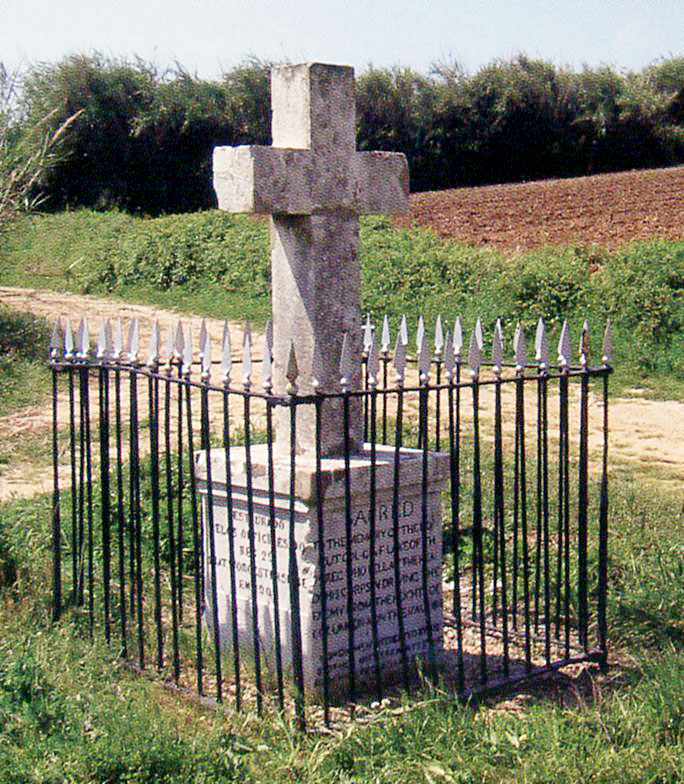
Delaborde did not wait for the attack.
Whilst his skirmishers engaged the advancing British, the French main body marched the mile back to the position above Columbeira, leaving Wellesley with his attack frustrated.
The new French position was very different from the first.
The French infantry were now at the top of a steep cliff, flanked on each side by a ravine.
After a reconnaissance, Wellesley decided to repeat the operation, with Trant and Ferguson again carrying out wide flanking movements, while the rest of the army advanced to a frontal assault.
This attack would be made up four steep gullies that gave access to the top of the cliff.
While the main force waited for the two flanking movements to develop, the riflemen of the 60th and 95th took advantage of the ‘sharks’ teeth’ rocks to engage the French from behind cover.
Before the order could be given for the main assault, Lieutenant Colonel Lake of the 29th led his regiment forward in a lone premature attack up one of the gullies.
The 29th reached the head of the gully, under a heavy fire from both flanks, where they met the 4th Swiss Regiment.
The Swiss attempted to change sides, reversing their muskets and advancing to shake the hands of the British soldiers.
In the confusion that followed, the 29th was attacked in the rear by a French battalion and driven back down the hill.
Lake, who had ridden his horse up the steep slope, was killed and 4 officers and 30 men of his regiment taken prisoner.
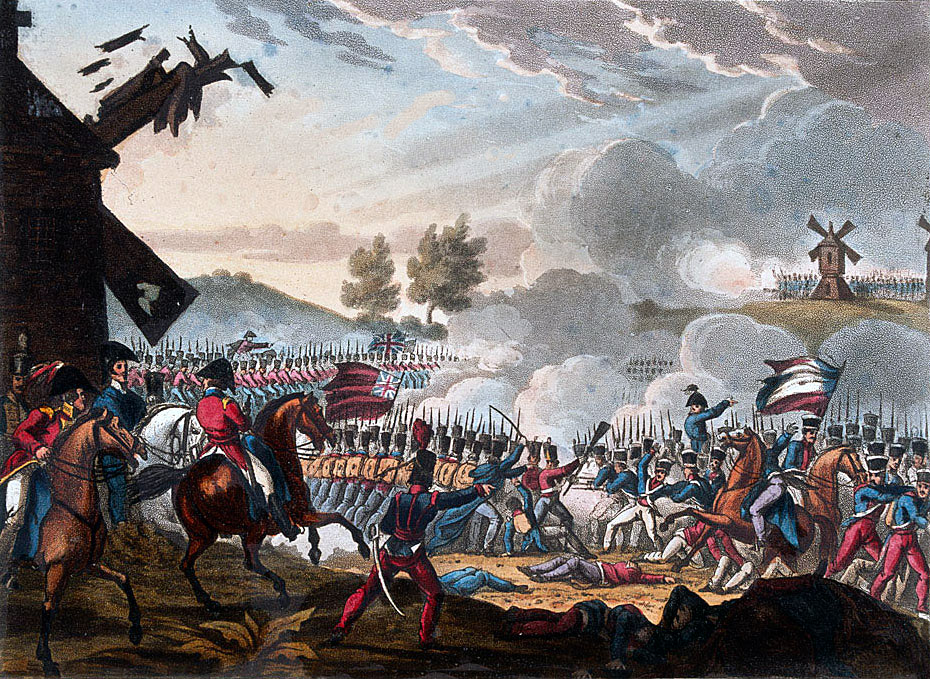
Led by the companies left at the bottom of the hill, the 29th renewed its assault, supported by the 9th Regiment.
Without waiting for the two flank attacks as originally planned, Wellesley ordered a general assault to rescue Lake and his men trapped at the top of the cliff.
The 5th Regiment attacked the French left flank, while the 60th and 95th advanced on the other flank.
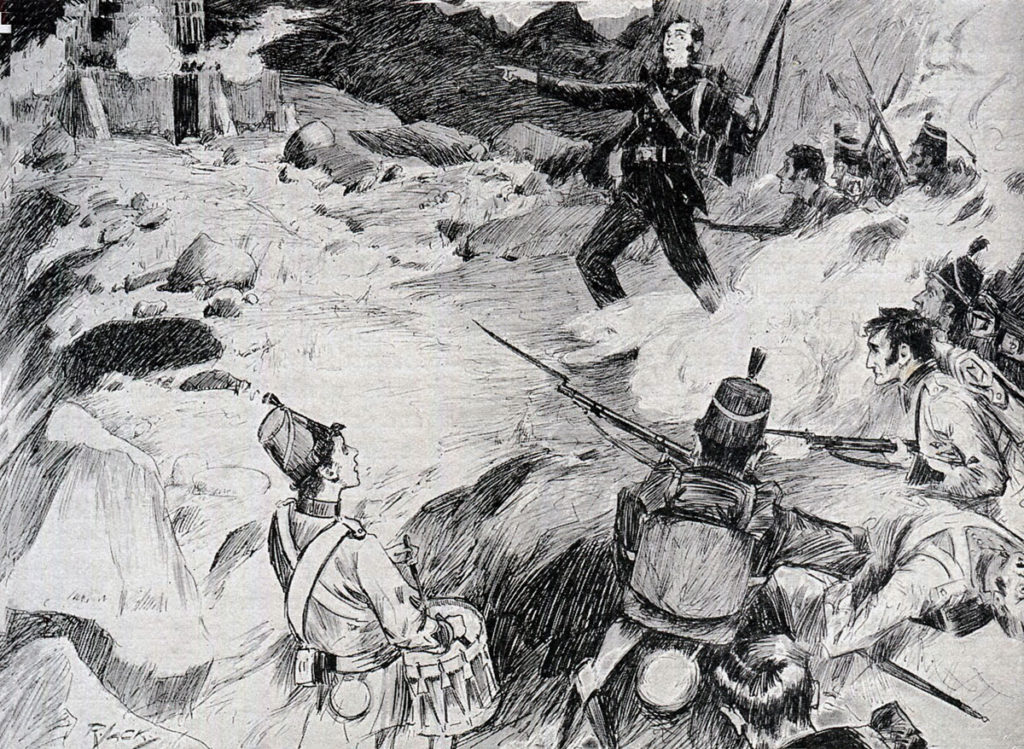
Delaborde launched three determined counter-attacks with his four remaining battalions, but was unable to prevent the British infantry from reaching the top of the cliff, supported as they were by heavy artillery fire.
Delaborde could now see that Ferguson’s two brigades were only a mile from his right rear and that he was in danger of being enveloped.
With considerable skill, Delaborde withdrew his battalions two at a time, while his cavalry threatened to charge the British infantry, causing them to pause in their pursuit.
After pursuing them through Zambugeira, the British infantry caught up with the French and captured 3 guns and some of the infantry.
Wellesley, concerned that Loison might be approaching the battlefield, abandoned the pursuit and Delaborde was left to march away.
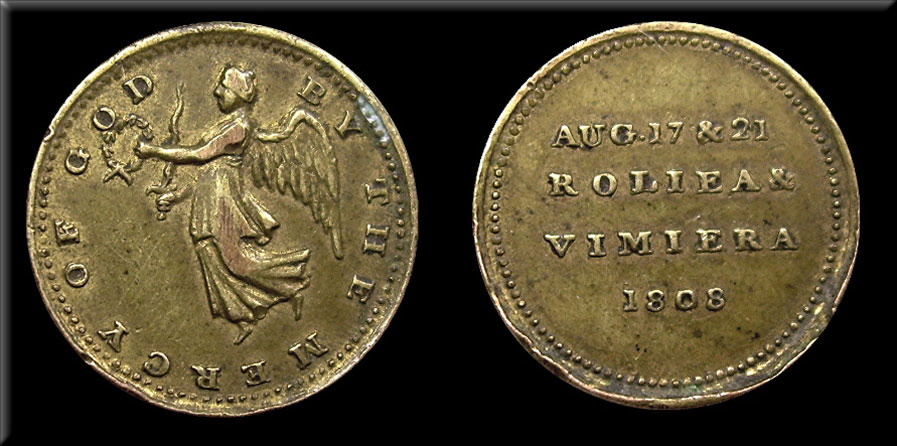
Casualties in the Battle of Roliça:
French casualties in the Battle of Roliça were 600 killed, wounded and captured. General Delaborde was wounded.
British casualties were 4 officers and 66 soldiers killed: 20 officers and 315 soldiers wounded and 4 officers and 78 men missing (taken prisoner).
Regimental casualties (apparently not including the missing) were:
20th Hussars: 3 soldiers wounded
Royal Artillery: 1officer killed and 1 soldier killed
Royal Engineers: 1 officer wounded
5th Regiment: 2 officers wounded, 3 soldiers killed and 41 wounded
6th Regiment: 1 officer wounded and 1 soldier wounded
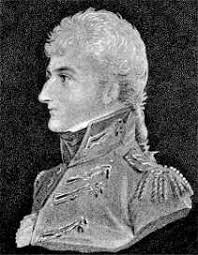
9th Regiment: Lieutenant Colonel Stuart was killed and 3 officer wounded, 4 soldiers killed, 49 wounded and 12 missing
29th Regiment: Colonel Lake killed and 7 officers wounded, 33 soldiers killed and 111 wounded
38th Regiment: 4 soldiers wounded
40th Regiment: 1 soldier killed and 2 wounded
45th Regiment: 1 officer killed and 1 wounded and 9 soldiers wounded
50th Regiment: 2 soldiers killed and 1 wounded
60th Rifles: 2 offices wounded and 8 soldiers killed and 39 wounded
71st Regiment: 1 soldier killed and 1 wounded
95th Rifles: 2 officers wounded and 17 soldiers killed and 30 wounded
The 36th and 91st suffered no loss.
Portuguese casualties were 33 killed and wounded.
Total: 428 casualties
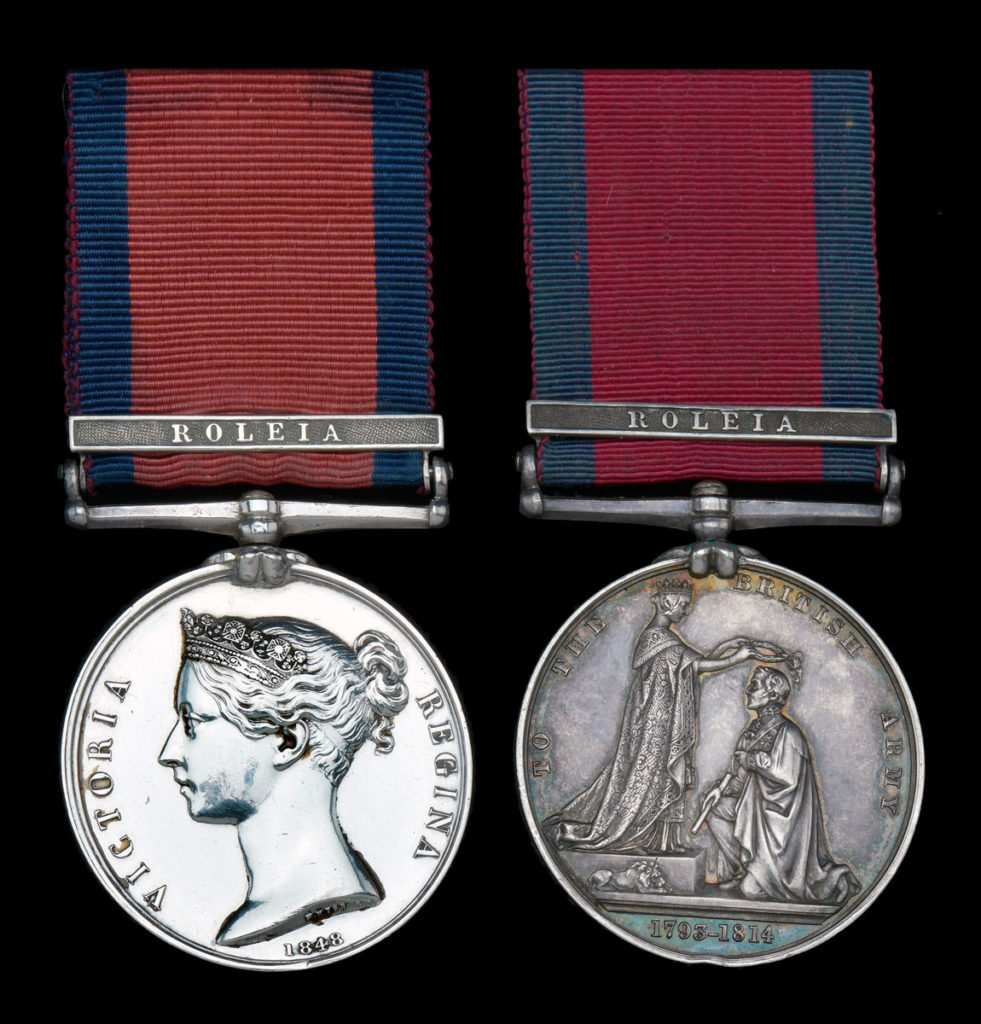
Aftermath to the Battle of Roliça:
After the Battle of Roliça, Wellesley continued his march towards Lisbon, giving battle to the French army of Marshal Junot at Vimeiro, 10 miles further south, on 21st August 1808.
Medal and Battle Honour for the Battle of Roliça:
The Military General Service Medal 1848 was issued to all those serving in the British Army present at specified battles during the period 1793 to 1840 who were still alive in 1847 and applied for the medal. The medal was only issued to those entitled to one or more of the clasps. There were 21 clasps available for service in the Peninsular War.
The Battle of Roliça (mistakenly embossed on the clasp as Roleia) was one of those clasps.
The battle honour ‘Roliça’ (initially given as ‘Roleia’) was awarded to the following regiments: 5th, 6th, 9th, 29th, 32nd, 36th, 38th 40th, 45th, 60th, 71st, 82nd, 91st and 95th Regiments.
Army Gold Medal:
In 1810 a Gold Medal was issued to be awarded to officers of rank of major and above for meritorious service at certain battles in the Peninsular War, with clasps for additional battles. The ‘Large Gold Medal’ was awarded to generals, the ‘Small Gold Medal’ to majors and colonels, with the medal replaced by a cross where four clasps were earned. The Battle of Roliça was one of the battles.
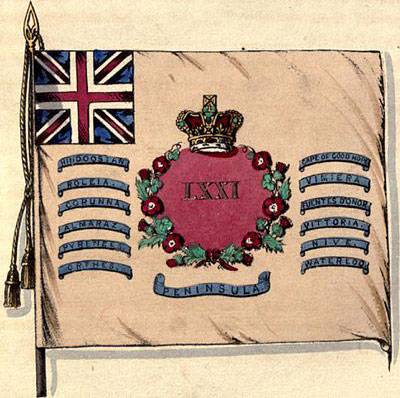
Anecdotes and traditions from the Battle of Roliça:
- Fortescue comments that the engagement at Obidos involving the 60th and 95th Rifles was the first British action of the Peninsular War.
- Fortescue comments on the battle: ‘[the battle’s] chief historic interest lies in the curious fact that he [Wellesley], who showed such surpassing skill in hiding his troops in a defensive position, should in his first action against the French have had to deal with an enemy concealed with a dexterity that he himself might have envied’.
- As the 95th Rifles climbed the Columbeira hill they were held up by French troops holding two buildings. The riflemen took cover until a soldier shouted ‘Over, boys, over.’ The regiment responded shouting ‘Over, over,’ and rushed the two buildings at the point of the bayonet.
- Lieutenant Colonel George Lake of the 29th Regiment, killed leading the premature attack on the heights of Columbeira, had been severely wounded at the Battle of Laswari in India on 1st November 1803, serving under his father, Lord Lake, the British commander at the battle.
- Wellesley commented of Colonel Nicholas Trant, the British commander of the Portuguese force at the Battle of Roliça and many later actions that he was “a very good officer, but a drunken dog as ever lived.”
- The Portuguese Post Office issued a series of stamps in 1928 commemorating the Battle of Roliça.
References for the Battle of Roliça:
See the extensive list of references given at the end of the Peninsular War Index.
The previous battle in the British Battles sequence is the Battle of Laswaree
The next battle in the Peninsular War is the Battle of Vimeiro

The Podcast of the Battle of Roliça: The first battle fought by the British in the Peninsular War, on 17th August 1808; also, the first of the string of victories over the French won by Sir Arthur Wellesley, later the Duke of Wellington: John Mackenzie’s Britishbattles.com podcast on the battle.
